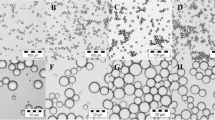Abstract
Purpose. Structured lipids (1,3-specific triglycerides) are new chemical entities made by enzymatic transesterification of the fatty acids in the 1,3 positions of the triglyceride. The purpose of this study is to characterize structured lipids with either short chain fatty acids or medium chain fatty acids in the 1,3 positions with regard to their hydrophobicity, and investigate the in vivo fate in order to evaluate the potential of structured lipids as core material in fat emulsions used as parenteral drug delivery system.
Methods. The lipids were characterized by employing reversed phase high performance liquid chromatography. The biodistribution of radio-actively labeled emulsions was studied in rats.
Results. By employing high performance liquid chromatography a rank order of the hydrophobicities of the lipids could be given, with the triglycerides containing long chain fatty acids being the most hydrophobic and the structured lipid with short chain fatty acids in the 1,3 positions the least. When formulated as fat emulsions, the emulsion based on structured lipids with short fatty acids in the 1,3 positions was removed slower from the general blood circulation compared to emulsions based on lipids with long chain fatty acids in the 1,3 positions.
Conclusions. The type of core material influences the in vivo circulation time of fat emulsions.
Similar content being viewed by others
REFERENCES
T. Yamaguchi and Y. Mizushima. Lipid microspheres for drug delivery from the pharmaceutical viewpoint. Crit. Rev. Ther. Drug Carr. Syst. 11:215–229 (1994).
S. S. Davis, C. Washington, P. West, L. Illum, G. Liversidge, L. Sternson and R. Kirsh. Lipid emulsions as drug delivery system. Ann. N. Y. Acad. Sci. 507:75–88 (1987).
S. S. Davis and L. Illum. Polymeric microspheres as drug carriers. Biomaterials 9:111–115 (1988).
G. Blume and G. Cevc. Liposomes for the drug release in vivo. Biochim. Biophys. Acta 1029:91–97 (1990).
L. Illum, P. West, C. Washington and S. S. Davis. The effect of stabilising agents on organ distribution of lipid emulsions. Int. J. Pharm. 54:41–49 (1989).
H. J. Von Fiebig. HPLC-Trennung von Triglyceriden. Fette. Seifen. Anstrichmittel 87:53–57 (1985).
O. Lutz, T. Lave, A. Frey, Z. Meraihi and A. C. Bach. Activities of lipoprotein lipase and hepatic lipase on long-and medium-chain triglyceride emulsions used in parenteral nutrition. Metabolism 38:507–513 (1989).
S. M. Moghimi, C. J. H. Porter, L. Illum and S. S. Davis. The effect of poloxamer-407 on liposome stability and targeting to bone marrow: comparison with polystyrene microspheres. Int. J. Pharm. 68:121–126 (1991).
M. Hultin, A. Müllertz, M. A. Zundel, G. Olivecrona, T. T. Hansen, R. J. Deckelbaum, Y. A. Carpentier, and T. Olivecrona, Metabolism of emulsions containing medium-and long-chain triglycerides or interesterified triglycerides. J. Lipid Res. 35:1850–1860 (1994).
M. Hamosh and P. Hamosh. Lipoprotein lipase: Its physiological and clinical significance. Molec. Aspects Med. 6:199–289 (1983).
O. Lutz, Z. Meraihi, J. Mura, A. Frey, G. H. Riess and A. C. Bach. Fat emulsion particle size: influence on the clearance rate and the tissue lipolytic activity. Am. J. Clin. Nutr. 50:1370–1381 (1989).
R. J. Deckelbaum, J. A. Hamilton, A. Moser, G. Bengtsson-Olivecrona, E. Butbul, Y. A. Carpentier and T. Olivecrona. Medium-chain versus long-chain triacylglycerol emulsion hydrolysis by lipoprotein lipase and hepatic lipase: Implications for the mechanisms of lipase action. Biochemistry 29:1136–1142 (1990).
S. Rössner, Studies on an intravenous fat tolerance test. Acta Med. Scand. Suppl. 564:3–24 (1974).
Rights and permissions
About this article
Cite this article
Hedeman, M., Brøndsted, H., Müllertz, A. et al. Fat Emulsions Based on Structured Lipids (1,3-specific triglycerides): An Investigation of the in Vivo Fate. Pharm Res 13, 725–728 (1996). https://doi.org/10.1023/A:1016095415849
Issue Date:
DOI: https://doi.org/10.1023/A:1016095415849




